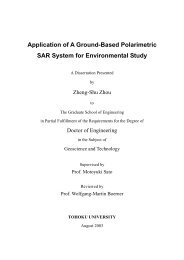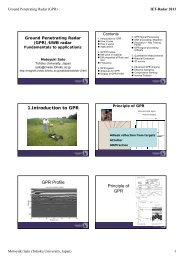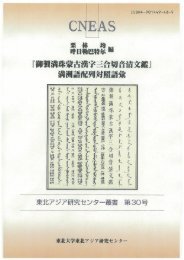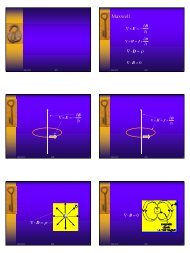Chapter 3: Vehicle-Mounted GPR System for Landmine Detection
Chapter 3: Vehicle-Mounted GPR System for Landmine Detection
Chapter 3: Vehicle-Mounted GPR System for Landmine Detection
Create successful ePaper yourself
Turn your PDF publications into a flip-book with our unique Google optimized e-Paper software.
3.2 Development of the <strong>System</strong> 31<br />
3.2.2 Use of three VNAs<br />
In this system, three pairs of antennas are used to acquire multi-offset data. In<br />
general <strong>GPR</strong> measurements of geological surveys, the data acquisition is done over<br />
and over again with changing the separation of antennas or with switching the signal<br />
using array antennas. However, the acquisition must be done three times <strong>for</strong> one<br />
position and the goal cannot be accomplished by using these methods. Our solution<br />
is simultaneous usage of three vector network analyzers. This manner can ideally<br />
reduce the acquisition time by 1/3 compared to the case of using only one VNA.<br />
There are two problems in the use of three VNAs simultaneously. One is the size<br />
and weight. In general, a VNA is a huge and heavy instrument, e.g. 35×22×46 cm<br />
and 25 kg (Anritsu MS4622). It is too large and heavy to carry three of them on a<br />
robot arm or even on a vehicle. Thus, the team of Tohoku University developed a<br />
new VNA shown in Fig. 3.4 together with Anritsu, Japan and USA under support of<br />
JST. It is very small, 20×30×5 cm, and very light weight, less than 1 kg without<br />
case, but it has almost the same per<strong>for</strong>mance as the general one, especially <strong>for</strong> the<br />
sweep speed and accuracy. The specifications are listed in Table 3.1.<br />
Fig. 3.4: Vector network analyzer employed in SAR-<strong>GPR</strong>.








